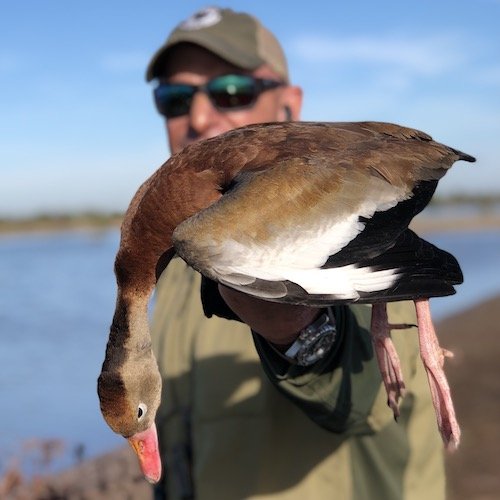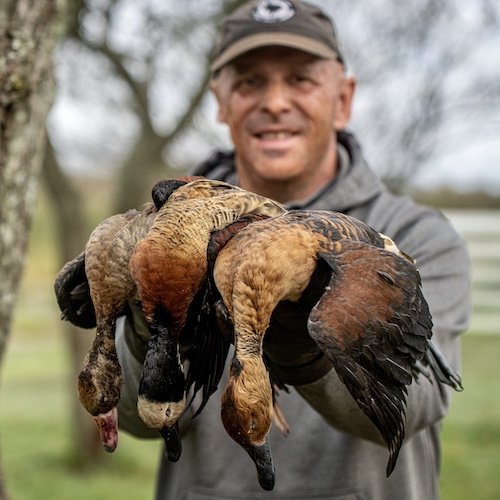Black-Bellied Whistling Duck
 Black-bellied Whistling Ducks (Dendrocygna autumnalis autumnalis), formerly known as “tree ducks,” because they are among the few waterfowl species that often perch in trees. These gregarious, mostly terrestrial, medium-sized dabblers are sexually monomorphic, meaning that both male and female black-bellied whistlers look similar, requiring cloacal examinations to accurately differentiate. They possess an “upright,” goose-like, posture formed by long, pale, bubble-gum pink feet and an elongated neck. Bright red-pink bills. As their name suggests, the underbelly and tail of this species is black, making their conspicuously large bright wing patches distinct whether folded or in flight. Upper wing coverts closely match grayish head plumage, the brown crown trailing down the neck and into the richly chestnut body. In flight, relatively slow wingbeats, sometimes in sizeable flocks, dark forms with large conspicuous white wing patches, contrasting black primaries, long legs under tail, constantly vocalizing high-pitched pee-chee-chee sounding whistle, to which they will readily decoy, and for which their Spanish name, pichiguila (pronounced peach-ee-whee-la) is derived.
Black-bellied Whistling Ducks (Dendrocygna autumnalis autumnalis), formerly known as “tree ducks,” because they are among the few waterfowl species that often perch in trees. These gregarious, mostly terrestrial, medium-sized dabblers are sexually monomorphic, meaning that both male and female black-bellied whistlers look similar, requiring cloacal examinations to accurately differentiate. They possess an “upright,” goose-like, posture formed by long, pale, bubble-gum pink feet and an elongated neck. Bright red-pink bills. As their name suggests, the underbelly and tail of this species is black, making their conspicuously large bright wing patches distinct whether folded or in flight. Upper wing coverts closely match grayish head plumage, the brown crown trailing down the neck and into the richly chestnut body. In flight, relatively slow wingbeats, sometimes in sizeable flocks, dark forms with large conspicuous white wing patches, contrasting black primaries, long legs under tail, constantly vocalizing high-pitched pee-chee-chee sounding whistle, to which they will readily decoy, and for which their Spanish name, pichiguila (pronounced peach-ee-whee-la) is derived.
Available Hunts
-
Argentina Duck Hunting Rio Salado
High-volume Argentina duck hunting a remote wetland that's well worth the effort.
...read moreArgentina duck hunting Rio Salado for die-hard duck hunters that will go the distance for high-volume shooting, high species diversity, and unspoiled habitat. Welcome to real Argentina.
- NO LONGER BOOKING THIS HUNT!
- Remote 74,000-acre wetland
- 1 hunter per blind unless requested
- Pure duck hunting
- Bilingual hosting for the entire trip
- Featured MOJO TV, Outdoor Life, Wildfowl, Sports Afield
Rate: N/A -
Mexico Duck Hunting Mazatlan
Mexico duck hunting Mazatlan ("honeymoon duck hunt") is the South-of-the-border duck hunting experience that surpasses all others.
...read moreMexico Duck Hunting Mazatlan is the easiest duck hunt you’ll ever get your wife onboard with because she’ll have just as much fun. Win-win duck hunting vacation as ever existed.
- Honeymoon duck hunting, non-hunting spouses enjoy it as much as hunters!
- January through mid-March (Valentine’s Day always sells-out first!)
- Resort hotel lodging, guaranteed great views (choose your own reservations and amenity levels while booking directly)
- Over 15 trophy duck species including Cinnamon Teal
- Generous 25-duck daily bag limits
- Many fun non-hunting activities
Rate: from $3,850 -
Mexico Duck Hunting Obregon
Mexico duck hunt combo for real duck hunters. All-day hunts for broad variety of Central Flyway and Pacific Flyway duck species.
...read moreMexico duck hunting combo in Obregon is an action-packed “real duck hunters duck hunt” for ducks, doves, options for trophy bass fishing and quail.
- Trophy duck species for nearly all Central and Pacific flyway species to include cinnamon teal, Mexican mallard, more!
- Generous bag limits
- Elegant and Gambel’s quail, trophy largemouth bass fishing options
- Premium, 9-bedroom estancia and unequalled guest services
- Featured – Wildfowl, World of Beretta, MOJO TV, Outdoor Life, NRA Hunter, more
Rate: $4,880 (4-day hunt) -
Mexico Duck Hunting Sonora
Mexico Duck Hunt package is intended for private groups of 4-7 hunters.
...read moreMexico Duck Hunting Sonora Combo was developed at the request of many repeat clients who wanted to enjoy morning Mexican duck hunting, afternoon dove hunts, with their own exclusive groups.
- 4-night, 3-day packages, January-February
- For private groups of 4-6 hunters
- Morning duck hunts, afternoon dove hunts
- Premium, 4-bedroom estancia, all bedrooms with ensuite facilities
- Excellent waterfowl species selection
Rate: $4,080 (3-day hunts)
 Black-bellied whistling ducks have a relatively small breeding range because they frequently will inhabit the same place year-round. Those that do migrate use land in Texas, Louisiana, Arkansas, and Mississippi. Those that do not migrate remain on the entirety of the coasts of Mexico, Arizona, and Florida. This species will form lifelong pair bonds, which is uncommon among most dabblers, choosing nesting sites together. Black-bellied whistling ducks build nests within natural or manmade cavities in heavily wooded areas or thickets. They will exhibit intraspecific brood parasitism, dumping their eggs in another pair’s nest.
Black-bellied whistling ducks have a relatively small breeding range because they frequently will inhabit the same place year-round. Those that do migrate use land in Texas, Louisiana, Arkansas, and Mississippi. Those that do not migrate remain on the entirety of the coasts of Mexico, Arizona, and Florida. This species will form lifelong pair bonds, which is uncommon among most dabblers, choosing nesting sites together. Black-bellied whistling ducks build nests within natural or manmade cavities in heavily wooded areas or thickets. They will exhibit intraspecific brood parasitism, dumping their eggs in another pair’s nest.
Primarily herbivorous, black-bellied whistling ducks can be found foraging nocturnally in lawns, agricultural fields, and shallow freshwater. Commonly consumed plant and animal materials include, but are not limited to, smartweed, sedges, millet, wheat, corn, spiders, and snails.
Black-bellied whistling ducks have adapted well to manmade areas which may be the difference between prospering and struggling populations. Historically limited to gulf coastal areas, black-bellied whistling duck distribution seems to be expanding. Post-hurricanes Katrina and Rita, in 2005, sightings and observed nest site observations became common throughout Arkansas, Louisiana and Mississippi delta regions, especially during the summer with many hunters reporting that black-bellied whistlers migrating out no later than mid-September. More recently, black-bellied whistling ducks are being observed much further north during the nesting period, to include Ohio, Delaware, Indiana. In January 2021, good numbers of black-bellied whistler were encountered while hunting one morning and am greatly encouraged.
There are 2 subspecies of black-bellied whistling ducks worldwide. The nominate race (D. a. autumnalis) is described above. The southern race (A. a. discolor) ranges from northern Argentina to Panama, where it may intergrade with autumnalis. The southern black-bellied whistling duck looks similar to the northern subspecies, but is somewhat smaller, duller, having a dull gray mantle and chest.



















